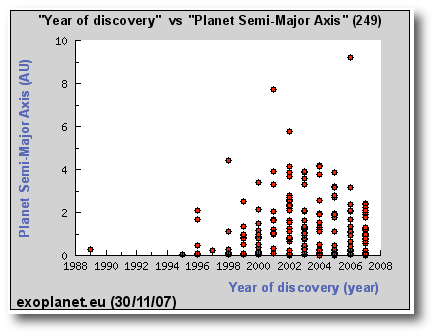
Image Source.
As the academic quarter draws to a close, it gets harder to keep up a regular posting schedule. This year, certainly, the difficulty has nothing to do with a lack of exciting developments associated with extrasolar planets.
A few unrelated items:
It appears that the HD 80606b Spitzer observations went smoothly, and that the data has been safely transmitted to Earth via NASA’s Deep Space Network. It is currently in the processing pipeline at the Spitzer Science Center. When it clears the pipeline, the analysis can start.
Back in September, I wrote a post about Bruce Gary’s Amateur Exoplanet Archive. This is a web-based repository for photometric transit observations by amateurs. With the number of known transits growing by the month, there’s a planet in transit nearly all of the time. Over 90 light curves have been submitted to the archive thus far. For transiting planets such as HD 189733b or HD 209458b, which have significant numbers of published radial velocity data, it’s very interesting to take the transit center measurements from Bruce’s archive and use them as additional orbital constraints within the console. The September post gives a tutorial on how to do this.
It really is turning out to be a banner year for extrasolar planets. As we head into December, this year is averaging more than one planet per week. The detection rate is more than double that of the previous four years.

The plot above gives a hint that Saturn-mass planets might wind up being fairly rare, as one might expect from the zeroth-order version of the core accretion theory. (For more information, this series: 1, 2, 3, 4, 5, 6, and 7 of oklo posts compares and contrasts the gravitational instability and core accretion theories for giant planet formation.)
Also, if you give talks, here’s a larger version of the above figure.
Another interesting diagram is obtained by plotting orbital period vs. year of discovery:

It’s possible that this diagram might be hinting that true Jupiter analogs are relatively rare. Could be that the disks around metal-rich stars are able to form Jovian mass planets and then migrate them in, while stars with subsolar metallicity form ice giants beyond the ice line. In this scenario, our solar system lies right on the boundary between the two outcomes.
It could also be the case that there are a whole slew of true-Jupiter analogs just on the verge of being announced. Time will tell.
And as always, it’s interesting to spend time with the correlation diagram tool over at exoplanet.eu.

Talking of true Jupiter analogues, the Catalog of Nearby Exoplanets has some rather interesting parameters for HD 154345b… Steinn Sigurðsson mentioned this one earlier this year, but as yet there has been no official announcement.
Hi Greg,
talking about interesting developments on extrasolar planets, there is a growing interest in polarimetric observations of exoplanet host stars.
In particular, I just came accross this paper that tentatively detects transits of a supposed hydrogen tail to 51 Peg b.
http://exoplanet.eu/papers/Ksanfomality_Polarimetry_Stars_Exoplanets_2007.pdf
The paper mentions that, if the effect is real, the transit of the tail could be detected in the ultraviolet.
I know your time is short but I would love to ear your thoughts on this technique and the possibility of using Hubble or Galex for example, to perform these observations.
Cheers,
Luis
If you put the pulsar planets on that graph (why do the pulsar planets seem to get routinely ignored?), we’ve already got known Earth-mass exoplanets, since 1992, plus a moon-mass world.
andy,
the trouble with pulsar planets is twofold: (1) they are not sufficiently ‘earth-like’: high radiation means no life (as we know it): They are not Earth analogues., and (2)a deficit of data, beyond the
periodic effects on the pulsar: eg. spectra from the planet, composition, etc. are hard to detect. Maybe later, if we get other techniques, but until the, all we can do is measure the mass and speculate.
Point 1 strikes me as a pretty poor reason not to study a planet, especially given the amount of study that non-“earth-like” gas giants get, and given that there are going to be many terrestrials and super-Earths which are NOT Earth-analogues, but point 2 is quite valid.
Nevertheless it is quite interesting that it apparently took Gliese 876d to kick off the theoretical study of “super-Earths” started, despite it receiving rather too much heat to be an Earth-analogue, when two super-Earths had been known for such a long time. Interesting also that the pulsar planets do not generally get mentioned as “super-Earths”.
The last diagram gave me an idea that I find great. If we assumed a distribution for planets depending on their relevant characteristics (mainly semi-major axis and mass), knowing how sensitive our methods of detection are, we could deduce the distribution of detected planets we’d have, and then we can use that to weight the distribution of planets we know of to deduce a closer estimate to what the true distribution of planets must actually be.
If I’m not making myself sufficiently clear, let’s take an example. Let’s pretend that in the universe there are as many Jupiter-like planets between 1 AU and 2 AU as there are between 4 AU and 8 AU, but that if it was the case, using our detection methods, we would found 5 times as many planets between 1 AU and 2 AU as between 4 AU and 8 AU. Now if we look at the Jupiter-like planets we actually know of and find that we know 7 times as many of them between 1-2 AU as between 4-8 AU, we could deduce that in reality there are 1.4 times as many between 1-2 AU as between 4-8 AU.
Furthermore we could apply that to mass, semi-major axis and star mass, this way we could not only properly weigh the distribution in the area covered by the planets we already know of, but we could define more clearly which areas we ignore everything of.
Or has it already been somehow done?
Hi Michel,
That’s an interesting point. I think what you’re describing is pretty close to a Bayesian analysis. I know that Eric Ford has been working on this approach for fits to individual systems, but I don’t know whether it’s been applied to a distribution of systems as you are suggesting…
Pingback: systemic - Superearths